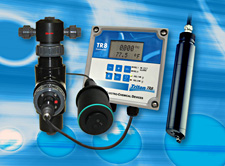Turbidity
Accurate measurement of turbidity is important in a wide range of surface water, municipal water and industrial water treatment applications. Turbidity is the cloudiness or haziness of a water sample, which is caused by suspended particles in the water, typically clay and silt. Viruses and bacteria can attach themselves to these particles making Turbidity a critical indicator of overall water quality.
The Triton® TR8 Turbidity Analyzer’s sensor measures turbidity with a unique multi-path optical assembly. The first light path is a reference detector that compensates for changes in the LED light source caused by aging or other variables. The second light path detects the short path length, which is best for high concentration measurements. The third light beam measures the longer path length, which is best for lower concentrations.
The Triton TR8’s sensor assembly relies on a long-life near infrared LED light source (880 nm), and the 90-degree scattered light method in accordance with ISO 7027 / EN 27027. The sensor is factory calibrated in formazine, FNU (Formazine Nephelometric Units), and is plug-and-play ready for applications. Two nonvolatile memory banks are also available onboard to store user-initiated calibration data.
ECD manufactures a complete product line of turbidity electrodes, turbidity sensors, turbidity controllers, turbidity meters, turbidity transmitters and turbidity analyzers.

